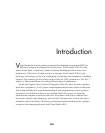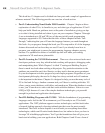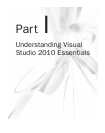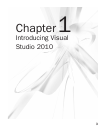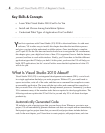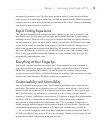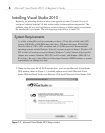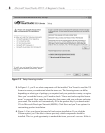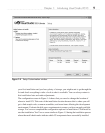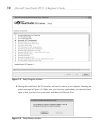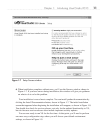
4 Microsoft Visual Studio 2010: A Beginner’s Guide
Key Skills & Concepts
● Learn What Visual Studio 2010 Can Do for You
● Install and Choose Among Installation Options
● Understand What Types of Applications You Can Build
Y
our first experience with Visual Studio (VS) 2010 is often installation. As with most
software, VS is rather easy to install; this chapter describes the installation process
and gives you tips to help understand available options. Once installation is complete,
you’ll open VS for the first time and need to know how to navigate the VS environment;
this chapter gives you a high-level view of how VS is organized, how to find the features
you need, and how to work with windows. Finally, you’ll learn how to find the different
application types that VS helps you build. At this point, you know that VS will help you
build .NET applications, but let’s start off with a more detailed explanation of what VS
will do for you.
What Is Visual Studio 2010 About?
Visual Studio 2010 (VS) is an integrated development environment (IDE); a set of tools
in a single application that helps you write programs. Without VS, you would need to
open a text editor, write all of the code, and then run a command-line compiler to create
an executable application. The issue with the text editor and command-line compiler is
that you would lose a lot of productivity through manual processes. Fortunately, you have
VS to automate many of the mundane tasks that are required to develop applications. The
following sections explain what VS will do for you and why VS is all about developer
productivity.
Automatically Generated Code
VS includes a suite of project types that you can choose from. Whenever you start a new
project, VS will automatically generate skeleton code that can compile and run immediately.
Each project type has project items that you can add, and project items include skeleton
code. In the next chapter, you’ll learn how to create projects, add project items, and view




